--- Watch Silvia Colloca share all the joys of Italian cooking weeknights in Made in Italy and Cook like an Italian episodes from 6pm on SBS Food through to 30 October ---
When it comes to dining out down under, Italian food is an undoubtable favourite. Spend a night in and you’ll find it easy to recreate entrees, mains and dessert with little fuss. Stock up on these pantry staples for cooking sessions of cucina instinctiva – instinctive cooking, in your very own home.
Australia is peppered with Italian food stores and delis, meeting the demand of migrants who came to Australia in the 1950s and missed the flavours of home, so there’s no shortage of places to pick up all the necessary staples. Alongside the obvious dried spaghetti and orecchiette, here’s what you’ll need: Olive oil
Olive oil

Olive oil is a staple in any Italian kitchen for cooking and garnishing. Source: Cook like an Italian
"Olive oil is, to me, the most staple ingredient in my pantry," says chef and owner of Melbourne's Rosa's Canteen, Rosa Mitchell. "What would we do without it? I finish most dishes with a drizzle of oil, I cook with it, I dress with it and I even use it as a moisturiser on my skin!"
Preserved anchovies
Another of Mitchell's favourites is the humble anchovy. "Sometimes we add so many ingredients to a sauce dish that we lose the individual flavours. So, I use anchovies to enhance a pasta dish, add it to a salad dressing. If you salt and prepare them yourself you get a better, fresher tasting anchovy. Just top it on a piece of bread and eat."
Canned chickpeas
Chef and cookbook author Silvia Colloca says the typical Italian home cook is intrinsically frugal. "We want to spend less and get more, and one thing that is ever-present in an Italian pantry is pulses. Beans or chickpeas, they are so versatile, so packed full of nutrients and high in protein." She always keeps a few cans on hand to whip up a quick meal.
Flour
"When it comes to essential Italian pantry staples, having good flour for bread is probably the most indispensable ingredient of them all," says Colloca. "I love using traditional flour for bread, but I find that a gluten-free mixture, made from rice, potato and soy flours, kneads beautifully."
Colloca uses a gluten-free mixture to cater for her coeliac friends when making breads, like this schiacciata.
READ MORE

Gluten-free schiacciata

Not just for dessert, use semolina in this Neapolitan semolina and ricotta cake (migliaccio). Source: Cook Like an Italian
Though it sounds a little fancy, semolina is quite a humble ingredient. The coarse, yellow flour made from durum wheat is an integral part of Italian cooking. Semolina finds its way into an array of dishes and desserts, including traditional pastas, gnocchi, pizza, bread, puddings and cookies. It's more aromatic and higher in protein compared to regular wheat flour.
Capers
Capers are the buds of a flower that are picked, dried and then preserved in rock salt or vinegar. "Capers are also used pretty much in the same way as anchovies," Mitchell says. "In salads, pasta and you can deep fry them for extra crunch." Dried porcini mushrooms
Dried porcini mushrooms

Nonna Irene’s sausage stew with soft polenta Source: Cook like an Italian
When revived from their dried state, porcini mushrooms provide an impressive earthiness, and add an almost meaty flavour to dishes. Use these beauties to create stocks, add to soups and stews, or flavour polenta.
Polenta + tomatoes

Nonna Irene’s sausage stew with soft polenta
Tinned tomatoes
What would an Italian do without a can of tinned tomatoes in the pantry? Tinned tomatoes are incredibly versatile, laying the foundation for a myriad of dishes from simple sauces like passata, napoletana and marinara to name a few. They are used to enhance soups, provide a base for pizzas, cover delectable meatballs and create a ragu…the list is almost endless.








